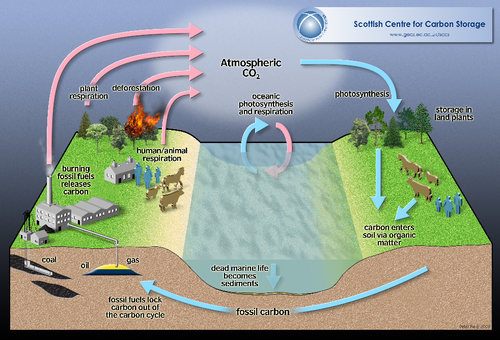Carbon Cycle
Contents
Key Stage 3
Meaning
The Carbon Cycle is a set of processes that naturally recycle Carbon.
About the Carbon Cycle
- Some processes put Carbon into the atmosphere as Carbon Dioxide and others take Carbon Dioxide out of the atmosphere.
| This diagram shows Carbon Cycle which shows how photosynthesis takes Carbon Dioxide out of the atmosphere. |
Adding Carbon Dioxide to the Atmosphere
- Respiration - All living creatures respire and produce Carbon Dioxide.
- Combustion of Fossil Fuels - When Coal and Crude Oil are burned they produce Carbon Dioxide.
- Decay - When organisms rot or decay the process produces Carbon Dioxide.
- Volcanoes - These release Carbon Dioxide into the atmosphere.
Removing Carbon Dioxide from the Atmosphere
- Photosynthesis - Most Carbon Dioxide is taken out of the atmosphere by algae photosynthesising in the oceans.
- Dissolving in Oceans - The Oceans absorb Carbon Dioxide.
- Making Shells - Sea creatures with hard shells use Carbon Dioxide dissolved in the water.
Carbon Sinks
A Carbon Sink is part of the Earth that absorbs and stores Carbon.
- The Ocean is a Carbon Sink storing a large amount of dissolved Carbon Dioxide.
- The Sea bed is a Carbon Sink where many organisms, that are made of mostly Carbon, fall to the bottom and get trapped in sediment.
- Forests are Carbon Sinks as the trees use photosynthesis to grow.
- Swamps are Carbon Sinks as many plants get stuck under the water and cannot decay. This Carbon eventually becomes Coal trapped underground.
